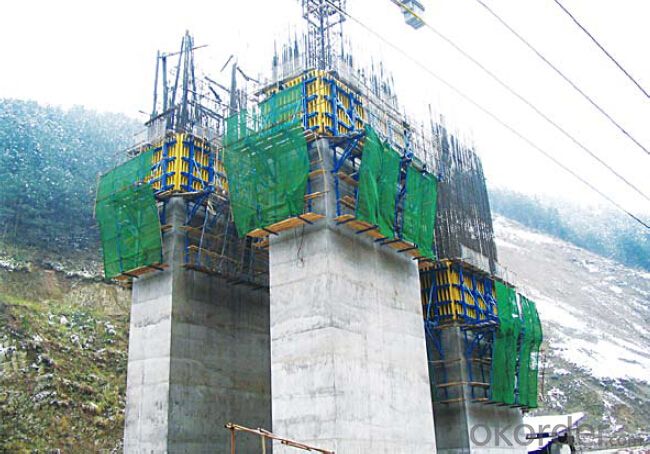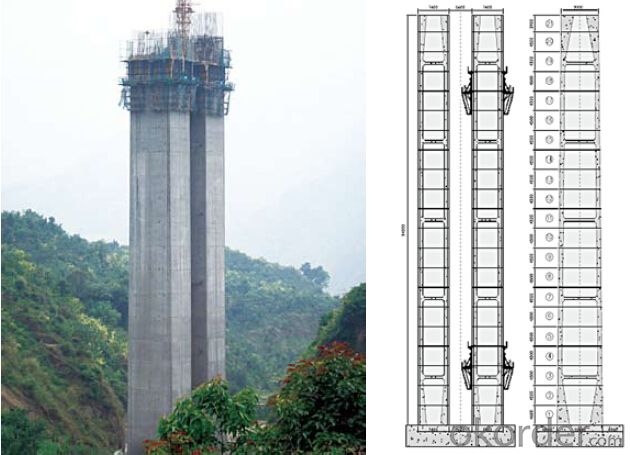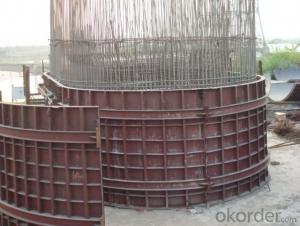Climbing bracket CB240 for formwork and scaffolding systems
- Loading Port:
- Tianjin
- Payment Terms:
- TT OR LC
- Min Order Qty:
- 50 m²
- Supply Capability:
- 1000 m²/month
OKorder Service Pledge
OKorder Financial Service
You Might Also Like
Climbing Bracket CB240 & CB210
They are framework brackets for supporting large-area wall formwork.
Typical applications for the CB240&CB210 are pier and column/shear wall/core walll/ in the
building.
CB210 has smaller size than CB240, it will be cost effective in some condition.
Characteristics:
◆ High bearing capacity
The high loading capacity of the brackets allow very large scaffold units. This saves the number
anchor points required as well as reducing climbing times.
◆ Simple moving procedure by crane
Through the strong connection of formwork together with the climbing scaffold, both can be moved
as a single climbing unit by crane. Thus valuable time-savings can be achieved.
◆ Fast striking process without a crane
With the retrusive set, large formwork elements can also be retracted quickly and a minimum of
effort.
◆ Safe with work platform
The platforms have assembled firmly with bracket and will be climbing together, without scaffolding
but can work safely in spite of your high location.
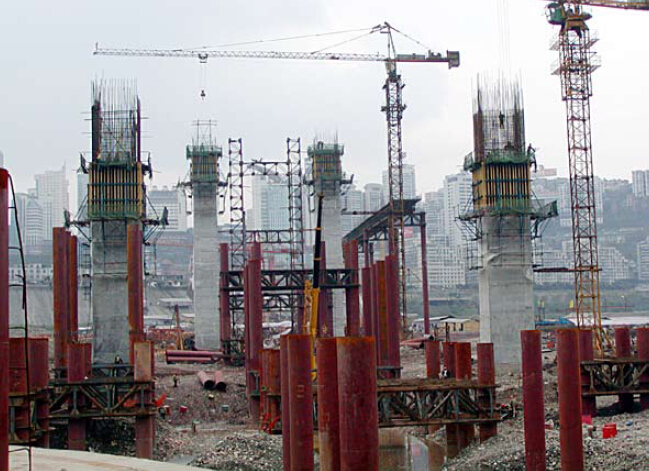
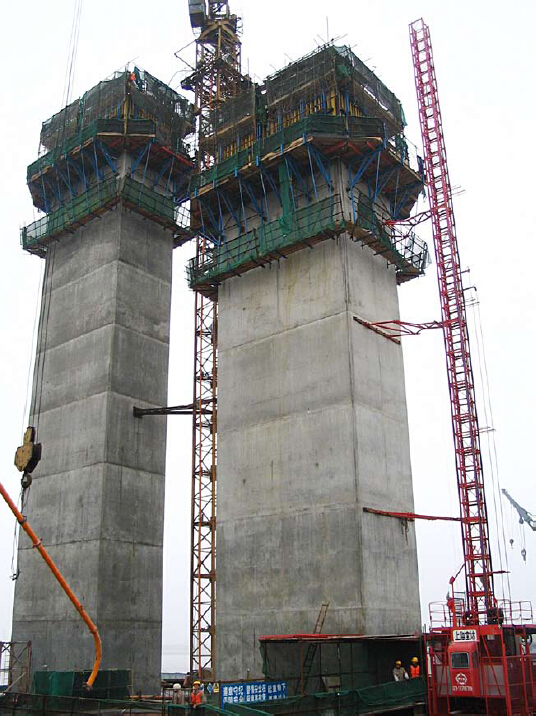
- Q: What are the common design considerations for steel formwork in high-rise construction?
- There are several common design considerations for steel formwork in high-rise construction. First and foremost, the load-bearing capacity of the formwork must be carefully evaluated. High-rise constructions often involve heavy loads, including the weight of the concrete, equipment, and workers. Therefore, the steel formwork must be designed to withstand these loads and ensure the safety of the construction process. Another important consideration is the durability and longevity of the formwork. High-rise construction projects can take several months or even years to complete, so the formwork needs to be able to withstand prolonged use and exposure to various weather conditions. Steel formwork is preferred in high-rise construction due to its strength and resistance to wear and tear. The design of the formwork should also take into account the ease of assembly and disassembly. High-rise construction projects often require frequent repositioning of the formwork as the building progresses. Therefore, the formwork system should be designed in a way that allows for efficient and quick assembly and disassembly, minimizing downtime and increasing productivity. Additionally, the flexibility and adaptability of the formwork design is crucial in high-rise construction. The formwork needs to be able to accommodate different shapes and sizes of concrete elements, including columns, walls, and slabs. This requires a well-thought-out formwork system that can be easily adjusted and modified to meet the specific requirements of each construction phase. Furthermore, safety is a paramount consideration in high-rise construction. The formwork design should incorporate appropriate safety features such as handrails, guardrails, and non-slip surfaces to prevent accidents and ensure the well-being of workers. Lastly, cost-effectiveness is an important consideration. High-rise construction projects can be financially demanding, and the formwork design should aim to minimize material and labor costs without compromising on quality and safety. In conclusion, the common design considerations for steel formwork in high-rise construction include load-bearing capacity, durability, ease of assembly and disassembly, flexibility, safety, and cost-effectiveness. By addressing these factors, engineers and designers can ensure the successful and efficient execution of high-rise construction projects.
- Q: How does steel formwork contribute to the sustainability of the construction industry?
- Steel formwork contributes to the sustainability of the construction industry in several ways. Firstly, steel formwork is highly durable and long-lasting. Unlike traditional wooden formwork, which often needs to be replaced after a few uses, steel formwork can be reused multiple times, reducing the need for new materials and minimizing waste. This not only saves money for construction companies but also reduces the environmental impact of the industry by reducing the demand for timber. Secondly, steel formwork is more efficient and time-saving compared to other types of formwork. The use of steel allows for faster assembly and disassembly, reducing construction time and costs. This efficiency translates into reduced energy consumption and lower carbon emissions, thereby contributing to the sustainability of the construction process. Moreover, steel formwork offers flexibility and adaptability in design, allowing for the construction of complex structures with ease. This versatility reduces the need for additional materials and resources, as the same formwork can be used for various projects. This adaptability also minimizes construction waste, further enhancing the sustainability of the industry. Additionally, steel formwork has a high load-bearing capacity, enabling the construction of taller and stronger structures. This means that fewer materials are required to achieve the same structural integrity, reducing resource consumption and waste generation. The ability to construct more durable buildings also contributes to the long-term sustainability of the construction industry by reducing the need for frequent repairs or replacements. Lastly, steel formwork is recyclable. At the end of its lifespan, steel formwork can be easily and efficiently recycled, reducing the demand for new steel production and minimizing the environmental impact associated with its extraction and manufacturing. In conclusion, steel formwork contributes to the sustainability of the construction industry through its durability, efficiency, flexibility, load-bearing capacity, and recyclability. Its ability to reduce waste, energy consumption, and carbon emissions makes it an environmentally-friendly choice for construction projects, promoting a more sustainable and responsible construction industry.
- Q: Can steel formwork be used for decorative concrete finishes?
- Yes, steel formwork can be used for decorative concrete finishes. It provides sturdy support and precise shaping, allowing for intricate designs and smooth finishes in decorative concrete applications.
- Q: Can steel formwork be used in sports facility construction projects?
- Sports facility construction projects can utilize steel formwork, a versatile and durable option that presents several advantages. First and foremost, it boasts exceptional strength and stability, rendering it suitable for large-scale structures such as sports facilities. Steel formwork is capable of withstanding heavy loads and pressures, thereby guaranteeing the construction's integrity and safety. Furthermore, steel formwork is highly reusable, leading to significant reductions in construction costs and waste. It can be effortlessly disassembled, cleaned, and reassembled for future projects, making it an environmentally friendly choice for sports facility construction. Additionally, steel formwork permits precise and accurate construction. Its rigidity and dimensional stability guarantee the attainment of the desired shape and dimensions for the sports facility. This is especially crucial in sports facilities where precise measurements and uniformity are paramount for proper functionality. Moreover, steel formwork provides a smooth and uniform surface finish. This attribute is indispensable in sports facilities where the playing surface must be even and consistent to ensure fair gameplay and prevent injuries. To summarize, steel formwork is a suitable option for sports facility construction projects due to its strength, reusability, precision, and smooth surface finish. It offers numerous benefits and can contribute to the successful completion of sports facilities.
- Q: What are the different components of a steel formwork system?
- A steel formwork system typically consists of several components that work together to create a sturdy and reliable structure for concrete casting. These components include: 1. Panels: Steel formwork panels are the main part of the system and are usually made of high-quality steel sheets. These panels are designed to provide a smooth and even surface for concrete pouring. They come in different sizes and shapes to accommodate various types of construction projects. 2. Connectors: Connectors are used to join the panels together and ensure they remain in place during concrete pouring. These connectors can be in the form of clamps, bolts, or pins, and they help to create a tight and secure fit between the panels. 3. Props: Props or vertical supports are used to provide additional support and stability to the formwork system. They are designed to withstand the weight of the concrete and prevent the formwork from collapsing. Props can be adjustable in height, allowing for flexibility in formwork design. 4. Beams: Steel beams are used to support the weight of the formwork system and transfer it to the ground. These beams are typically placed horizontally and provide a strong framework for the panels and other components to rest on. They are often adjustable in length to accommodate different project requirements. 5. Bracing: Bracing elements, such as diagonal struts and cross braces, are used to reinforce the formwork system and prevent it from buckling or deforming under the pressure of the concrete. These bracing components are strategically placed to distribute the load evenly and enhance the overall stability of the system. 6. Accessories: There are various accessories that can be used to enhance the functionality and efficiency of a steel formwork system. These include corner pieces, wedge bolts, release agents, and chamfer strips. These accessories help to improve the overall performance of the formwork system and ensure smooth and accurate concrete casting. Overall, a steel formwork system is a comprehensive solution for creating strong and durable concrete structures. Its different components work together to provide stability, flexibility, and ease of use, making it a preferred choice in various construction projects.
- Q: Can steel formwork be used for foundation construction?
- Indeed, foundation construction can make use of steel formwork. Steel formwork proves to be a flexible and long-lasting alternative for the creation of foundations. It affords a solid and steady support system for the pouring of concrete and the achievement of the desired shape and structure of the foundation. Steel formwork presents various advantages, such as its easy assembly and disassembly, reusability, and capacity to withstand substantial loads and pressure. Moreover, steel formwork exhibits high resistance to moisture and can be effortlessly cleaned, rendering it suitable for application in foundation construction projects. All in all, steel formwork stands as a dependable and effective choice for the construction of foundations.
- Q: Can steel formwork be used for marine construction projects?
- Yes, steel formwork can be used for marine construction projects. Steel is a durable material that can withstand harsh marine conditions, including exposure to saltwater, waves, and corrosive elements. Steel formwork provides the required strength and stability to withstand the forces exerted by the marine environment. It can be used for various marine construction applications, such as building seawalls, piers, jetties, and offshore structures. Additionally, steel formwork offers advantages such as easy assembly and disassembly, reusability, and the ability to create complex shapes and structures. However, proper corrosion protection measures, such as galvanization or the use of anti-corrosive coatings, should be implemented to ensure the longevity and performance of the steel formwork in marine environments.
- Q: Can steel formwork be used in combination with other types of formwork?
- Yes, steel formwork can be used in combination with other types of formwork. It is common to use steel formwork in conjunction with timber or aluminum formwork systems to provide enhanced structural support and flexibility in construction projects. This combination allows for efficient and cost-effective construction processes while maintaining strength and durability.
- Q: What are the considerations when designing steel formwork for stairs?
- When designing steel formwork for stairs, several important considerations need to be taken into account. Firstly, the structural integrity and load-bearing capacity of the formwork must be carefully evaluated to ensure it can support the weight of workers, materials, and any equipment used during the construction process. Additionally, the formwork should be designed to provide sufficient stability and rigidity to prevent any deformation or movement during concrete pouring and curing. The dimensions and shape of the stairs, including the riser and tread dimensions, should be accurately calculated to meet safety and accessibility standards. Lastly, attention should be given to ease of assembly, disassembly, and reusability of the formwork to optimize efficiency and cost-effectiveness in construction projects.
- Q: Can steel formwork be used for projects with limited formwork storage space?
- Yes, steel formwork can be used for projects with limited formwork storage space. Steel formwork is known for its durability and reusability, making it a preferred choice for projects with limited storage space. Unlike traditional timber formwork, steel formwork can be easily dismantled and stored in a compact manner, allowing for efficient use of limited storage space. Additionally, steel formwork can be quickly assembled and disassembled, reducing the time and effort required for formwork installation and removal. Overall, steel formwork is a suitable option for projects with limited formwork storage space due to its compact storage capabilities and easy handling.
Send your message to us
Climbing bracket CB240 for formwork and scaffolding systems
- Loading Port:
- Tianjin
- Payment Terms:
- TT OR LC
- Min Order Qty:
- 50 m²
- Supply Capability:
- 1000 m²/month
OKorder Service Pledge
OKorder Financial Service
Similar products
Hot products
Hot Searches


